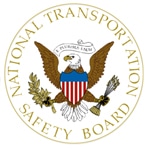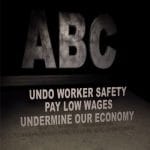
The Special Investigation Report on Railroad and Rail Transit Roadway Worker Protection provides details of 14 fatal accidents in 2013. Over the year, 15 roadway workers died. The number of deaths in 2013, the findings from investigations of those deaths and the increasing number of fatalities prompted the NTSB to look more closely at the issue of roadway worker safety and to recommend actions to address these issues.
Railroad and rail transit roadway workers are subject to on-the-job risks and hazards that are markedly different from those faced by other railroad employees. Of the fatalities in 2013, 11 resulted from 11 accidents on freight railroads and four were on commuter or transit railways. The average number of railroad worker fatalities has fluctuated but has remained about 6.4 per year from 1990 to 2013.
“Railroad roadway worker deaths have increased over the past three years,” said NTSB Acting Chairman Christopher A. Hart. “This trend is unacceptable.”
Among the report’s findings are that comprehensive job briefings could help prevent accidents and that national inspection protocols for work activities are necessary to ensure the safety of roadway workers.
The NTSB issued recommendations to the Federal Railroad Administration, the Federal Transit Administration, the Occupational Safety and Health Administration and the Fatality Analysis of Maintenance-of-Way Employees and Signalmen Committee. The recommendations call for additional training, harmonization of standards, a national inspection program and greater stakeholder participation in roadway worker fatalities, among other measures.
A summary of the special report is available at http://go.usa.gov/dZfj.
Author: paul

The State Building and Construction Trades Council of California has recently produced an excellent and compelling video that pulls back the curtain from the slick public relations efforts of the Associated Builders and Contractors (ABC) and exposes the true nature of its destructive business model. From striving to keep wages low in the construction industry, to making virtually no investments in apprenticeship training and workforce development, the ABC has for generations been an anathema to preserving middle class standards for careers in the construction industry.
This hard hitting video lifts the veil around this group and exposes it for its’ hypocrisy.

I have been involved in this union for 45 years. There has never been a more outspoken, honest, and hardworking General Executive Council than the one we have now. They do what is right for this membership. They make this union. It also helps having a great partner, a general secretary-treasurer who has your back and who makes you proud every day. Joe Sellers is a great leader.
We are now one union. I know that some differences of opinion among the membership remain as in any democratic organization that respects the right of each and every member to speak freely. I will always continue to encourage discussion, debate and your input on where we go in the future.
As I told the convention delegation, we are going to fight some, and we are going to bleed some. But in the end, we’ll all bleed the same blood.
We closed the convention on Aug. 15 as one union. We are not divided and we will not let anything divide us. A house divided will fall and we will never go that way. We have a combined legacy of 270 years. We must build on what previous generations have passed to us by furthering our mission to make this union even stronger in servicing our members.
I am telling you what I told the assembled delegates at the convention. All business managers, business agents, general chairpersons and local chairpersons must realize that service to the membership must come first. Whether they are representing airline, rail, transportation or sheet metal members, our leaders must continue their duty to represent the membership to the best of their ability.
This union’s leadership will not tolerate anyone who doesn’t represent their members. You don’t have to like Joe Nigro, but you do have to like and work for your membership.
Through education, strength and unity, we will fulfill our mission to make SMART the strongest union in North America.
As I noted in my column here last month, I was never as proud of our members as I was to see our sheet metal brothers and sisters standing shoulder to shoulder with our transportation membership at a rally held by employees on the Long Island Rail Road.
It was outstanding to see sheet metal workers and transportation workers getting together and fighting together on behalf of their brothers and sisters. When I walked into that parking lot with more than 3,000 people, I was so proud.
Our membership was successful in obtaining a fair agreement with the New York Metropolitan Transportation Authority and I congratulate LIRR GO 505 General Chairperson Anthony Simon and his leadership team for that outstanding effort.
We departed our first SMART convention renewed, stronger and united. We will continue to forge a new future with the dignity, integrity and the honor that went into building this great union. To read and view coverage from the First SMART General Convention, visit your union’s website at smart-union.org.
It’s all about our union, our members and our strength. Together, we are all SMART.
Joseph J. Nigro
SMART General President

There is a gap of knowledge between professionals who design, fabricate and install duct work and the experts who inspect it after it’s in full operation. Although they work in the same world, they are very different industries with different lingo, protocol, codes and regulations. Getting these two industries to understand each other can create energy efficient buildings and save lives in case of fire. The Building Inspectors Program, a course developed by the International Training Institute (ITI) helps to bridge the gap by breaking down walls created by their differences and increasing communication, respect and relationships between sheet metal contractors, and the building and fire inspectors. “It’s more of an awareness class for the building inspectors, so they know what’s out there,” said Larry Lawrence, ITI instructional development specialist and field representative. “They just need to know if the systems are installed correctly.” The program brings local building inspectors into the training center to discuss the proper installation of HVAC systems, including Fire Life Safety and how to spot improper installations of smoke and fire dampers. In a building, the HVAC system can provide a highway for smoke to spread to other rooms, and dampers serve as road blocks to keep rooms smoke free. The dampers allow valuable time for the buildings’ occupants to exit and the first responders to get inside and extinguish the fire. The ITI trains instructors and training directors to host the Building Inspectors Program at their local training schools to educate and build relationships with the inspectors in their communities. Tim Myres, training director at Local No. 20, plans to host the program in September in Indianapolis. “It’s such a good tool,” Myres said. “We found out the inspectors were calling us and asking us questions. They’re trying to do their jobs, and they have questions. They’re like anyone else — they look to an expert for advice — so we do receive calls. It’s a win-win.” The program has had success in Pennsylvania, Ohio and, most recently, in Phoenix, Arizona. Property managers, building owners, maintenance managers and anyone who has to do with the air delivery system in a building can attend the program. In Philadelphia, the program opened the lines of communication. “The building inspectors and the building owners didn’t realize there was so much involved in the delivery of air. That was the initial impact,” said Aldo Zambetti, field representative for the ITI and Building Inspector Program instructor. “We became the subject matter experts when they had questions. They had a resource to go to get answers.”
For some workers, having to sit through captive audience meetings where employer representatives tell you that, “you have the right to organize, but it would be a very bad idea” has become mandatory while on the way to organizing for a voice at work.
A new trend has emerged, however, where some workers have been able to secretly record these meetings. These recordings offer a sneak peek at what some companies have been doing to keep workers from forming a Union.
Dave Jamieson, a Labor reporter at the Huffington Post, released an article this week covering three companies — Coca-Cola, FedEx, and Staples — which have had their captive audience meetings recorded by attendees. The similarities when it comes to the messaging from the union busters employed by these companies is uncanny.
The audio of all three of these meetings can be found on HuffingtonPost.
In the case of Coca-Cola, workers were quick to realize they were not, “just being informed of their options.” The tone of the meeting is always anti-union, with suggestions such as: “When a union comes in […] they’re seeking money from employees.”
In rare cases, these meetings give workers the opportunity to confront the lies they are being told by management. Here’s another excerpt from the Coca-Cola meeting:
When the man says that all unions want is money, one worker asks him how much he is being paid to hold the information session.
“How much is your salary for this meeting, as far as you talking about unions and stuff like that?”
“My salary doesn’t matter,” the man replies. “This is my job. I work for Coke just like you do.”
After being warned about the costs of union representation, the worker responds, “I wouldn’t mind paying for representation, because I don’t feel like anyone is representing me [now].”
“Why would people go seek a third party?” one worker asks. “You get what I’m saying? There has to be a problem.”
“You put so much emphasis on discouraging people about the union,” another worker says. “Why wouldn’t you put the same emphasis on finding out what problems the employees have and try to make them better?”
The worker who recorded the meeting told Jamieson that the thought of unionizing is necessary because “pay is not matching the labor.”
“Most guys believe that if I give a fair day’s work I should get a fair day’s pay,” he added.
These brief moments of truth, are not exclusive to Coca-Cola. Accidental confessions, when tempers flare and the meeting host breaks down and tells the workers what the company truly feels about them.
That’s what happened in the recorded FedEx Freight meeting:
“We do not want a union at FedEx Freight, not under any circumstances. Okay?” he (the union buster) says. “This company by any legal means necessary will fight that. And everybody in this room and everybody who works for this organization needs to understand that. We don’t support it. We don’t think it fits with our business model. We don’t think it’s good for you or your families.”
None of these meetings’ legal protection can complicate the simple concept of worker protection. As one Teamsters supporter working at FedEx told Jamieson, “I think it’s about time we had a voice.”
The much needed “Fair Play and Safe Workplace Executive Order,” signed by President Obama, provides new reporting requirements on federal contractors and limits contractors’ ability to impose arbitration clauses for certain types of workplace lawsuits.
According to a White House fact sheet, the order’s key provisions:
Hold corporations accountable for labor law violations
Crack down on repeat violators
Promote efficient federal contracting
Protect responsible contractors
Give employees a day in court
Give employees information about their paycheck
Streamline implementation and overall contractor reporting
For contracts valued at more than $500,000, the executive order requires contractors to disclose violations of more than 14 federal statutes, and their state law counterparts, which include, but are not limited to: OSHA, LMRA, ADA, FMLA, and civil rights laws. It also provides for “paycheck transparency,” requiring employees’ paychecks to include information on hours worked, rate of pay, overtime, additions, and deductions.
Another major component of the order prevents contractors with contracts of more than $1 million from requiring employees to consent to mandatory arbitration for certain types of legal disputes involving civil rights, sexual assaults, or harassment. The executive order not only requires contractors to disclose certain violations at the time of bidding, but it contains ongoing obligations to disclose new violations during the life of the contract. The Federal Acquisition Regulatory (FAR) Council will be responsible for implementing specific regulations necessary to carry out the executive order. Click here to view a White House notice about the Executive Order.
A new study, from University of Illinois-Urbana professors From Labor and Employment Relations professor Robert Bruno and Illinois Economic Policy Institute Director Frank Manzo found that just as “Right-to-Work” allows some workers to freeload to the detriment of others, it also allows states to promote an anti-labor business model on the dime of those who respect workers. Workers in “Right-to-Work” states account for 37.4 percent of federal income tax revenues, for instance, but receive 41.9 percent of non-health, non-retirement government assistance.
“Right-to-Work” states typically receive assistance from the federal government without paying their fair share. Workers in “Right-to-Work” states receive $0.232 in non-health, non-retirement assistance per dollar they contribute in federal income tax. Workers in collective bargaining states, on the other hand, receive $0.187 per federal income tax dollar, or 24 percent less.
Beyond affecting individual contributions to federal assistance programs, “Right-to-Work” laws contribute to the race to the bottom promoted by business interests looking to cut labor costs. The authors of the paper found that “Right-to-Work” laws:
• Reduce worker income from wages and salaries by 3.2 percent on average.
• Lower both the share of workers who are covered by a health insurance plan (by 3.5 percent) and the share of workers who are covered by a pension plan (by 3 percent).
• Reduce union membership rates by 9.6 percent.
• Increase the employment rate (by 0.4 percent), but at the expense of a lower labor force participation rate (by 0.5 percent).
Thought the study found that “Right-to-Work” states have seen a tiny increase in employment (0.4 percent), it does not offset the number of workers who drop out of the workforce (0.5 percent) or factor in the number of low-wage jobs the legislation brings about. Workers who no longer participate in the workforce often begin collecting public assistance which puts an increased burden on such programs.
“Working-age residents who drop out of the labor force depend more on government assistance, which raises the poverty rate and, in turn, leads to increased government spending on food stamps, as well as a lower share of workers who are covered by a health insurance plan,” Robert Bruno writes. “Government assistance in the form of food stamps and EITC benefits would have increased by over $440 million during that time,” Bruno said.
Although workers in states with right-to-work laws work slightly more hours per week and per year than their counterparts in collective bargaining states, that’s likely only because workers need to offset the effects of lower wages, Bruno said. “The question for policymakers is whether a small increase in the employment rate is worth a significant decrease in total labor income, a considerable decline in state income tax revenues, an even larger drop in federal income tax revenues and an increased erosion of public budgets,” he said. “Ultimately, the negative impact of right-to-work laws greatly outweighs the uptick in employment rates it creates.”
Focusing the argument on their home turf of Illinois, the researchers looked at what would have happened in the Land of Lincoln has “Right-to-Work” been in effect in 2013. The researchers found that the state’s labor income would have fallen by $12.3 billion and resulted in $4.8 billion in lost federal income taxes.
Kentuckians lose more than twice the amount of money to bad bosses than they do to robbers according to an odd new chart from the Kentucky Labor Cabinet. Comparing numbers from the Kentucky State Police to their own data, the office discovered $2.5 million more in wage theft (from 12,264 victims) than common theft (from 1,937 victims). “You hear about robberies on the news all the time, but wage theft is a bigger problem,” Kentucky Labor Cabinet Secretary Larry Roberts said (Visit We Party Patriots to learn more).
